研究案例:
Please choose:
WAVEGUIDE MODES:
Waveguide Modes - Command surfaces
It is well known that the orientation of a nematic liquid crystal can be controlled by an interface. In the following papers a nematic liquid crystal was confined within a cell. The surface of the cell was modified by a Langmuir Blodgett film containing azobenzene moieties. Azobenzene posses two distinct conformation and the prevailing conformation can be determined by light. The organization of the bulk phase was determined by the state of of the azobenzene. A cis surface yields an in-plane orientation a trans state a homeotropic orientation of the liquid crystal.
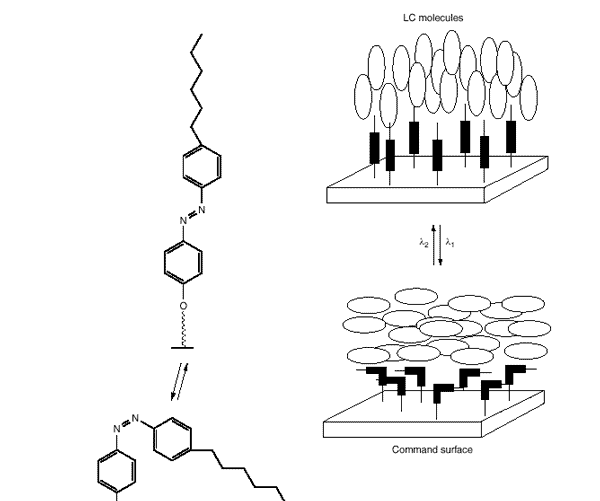
Further reading:
Command Surface Controlled Liquid Crystal Waveguide Structures as Optical Information Storage
H. Knobloch, H. Orendi, M. Büchel, T. Seki, S. Ito, W. Knoll
 J. Appl. Phys., 76, 8212 (1994) J. Appl. Phys., 76, 8212 (1994)
Photochromic Command Surface Induced Switching of Liquid Crystal Optical Waveguide Structures
H. Knobloch, H. Orendi, M. Büchel, T. Seki, S. Ito, W. Knoll
 J. Appl. Phys., 77, 481 (1995) J. Appl. Phys., 77, 481 (1995)
Waveguide Modes - NLO device ferroelectric liquid crytals
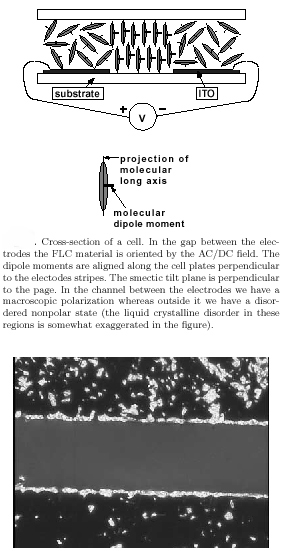
A binary mixture of ferroelectric liquidcrystals (FLCs)was used for the design of a channel waveguide.The FLCs possess two important functionalities:a chromophore with a high hyperpolarizability β and photoreactive groups.The smectic liquidcrystal is aligned in layers parallel to the glass plates in a sandwich geometry.This alignment offers several advantages, such as that moderate electric felds are suffcient to achieve a high degree of polar order. The arrangement was then permanently fixed by photopolymerization which yielded a polar network possessing a high thermal and mechanical stability which did not show any sign of degradation within the monitored period of several months. The linear and nonlinear optical properties have been measured and all four independent components of the nonlinear susceptibility tensor d have been determined. The photpolymerization did not induce scattering sites in the waveguide and the normalized losses were less than 2 dB/cm.The material offers a great potential for the design of nonlinear optical devices such as frequency doublers of low-powerlaser diodes.
Further reading:
V. Fazio, S. Lagervall, A. Hult, H. Motschmann
Phase matched Second-Harmonic Generation in a ferroelectric liquid crystal waveguide,
Applied Physics Letters, 77, 319, (2000).
V. Fazio, L. Komitov, C. Radüge, S. Lagervall, H.Motschmann
Influence of the flow on the anchoring of nematic liquid chrystals studied by optical second harmonic generation
European Physics Journal E: Soft Matter, 5, 309, (2001).
Waveguide Modes - SHG LB waveguide
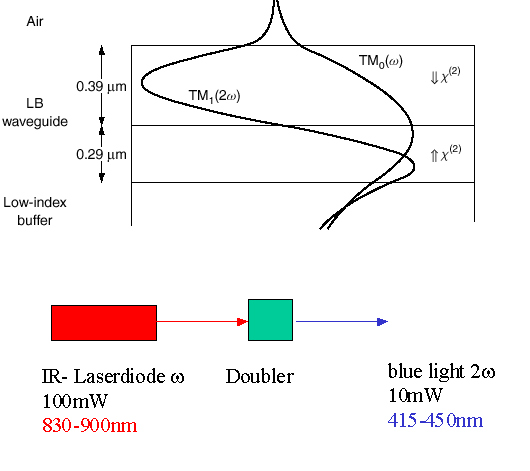
Optical layer structure of the waveguide prepared by LB deposition. The thickness was adjusted to achieve phase-matching between the zero-order mode of the fundamental and the first-order mode of the generated second-harmonic by using the modal dispersion of the guide. The exact thickness is given by the linear optical constants, with only low tolerances within the nm region being acceptable. Part (b) shows the electric field distribution for the zero-order mode of the fundamental at 900 nm and the first-order mode of the second-harmonic light. The power confinement was greater than 80%. Phase-matching can only be achieved between modes of different order which limits the value of the overlap integral, where the latter is given by the product of the field distribution of the interacting modes multiplied by and the nonlinear susceptibility. A reversal of the sign of the nonlinear susceptibility at the nodal plane maximizes the value of the overlap intergral. The sign reversal was achieved by a macroscopic inverted structure. The layer architecture is schematically represented in (a), where the NLO-active unit in the upper part is invented with respect to the lower part. The performance of the system scaled up to a channel waveguide confinementis close to a practical level of performance.
Further reading:
T. L. Penner, H. R. Motschmann, N. J. Armstrong, M. C. Enzenyilimba and D. J. Williams,
Nature, 367, 49 (1994)
back to top
ELLIPSOMETRY
Ellipsometry - Adsorption kinetics
A common application of optical reflection techniques such as ellipsometry is the study of adsorption processes. Ellipsometry provides valuable insights about layer growth and the prevailing interfacial architecture. The good time resolution of optical measurements allows an in situ monitoring of the underlying adsorption kinetics. The data analysis yields in favourable cases the following information:
· Mass coverage or adsorbed amount
· The layer thickness
· Orientation of molecules
· Morphology and homogeneity
A general statement of the outcome and the precision of adsorption measurement is not per se possible. The data interpretation must be accompanied by a critical assessment of internal correlations and an error analysis. Refractive index and layer thickness may be coupled and as a result only the mass coverage may be monitored. Sometimes it is possible to boost the sensitivity by slight modification of the system without changing the chemistry. A prominent example is a boost in the sensitivity by using oxidized silicon wafers ( 80- 160 nm) instead of wafers with a native oxide layer (2 nm). The use of oxidized silicon wafers provides a sufficient sensitivity in Delta and Psi even if monolayer are investigated.
Ellipsometry - Scaling laws of polymers
Dependence of thickness L, on chain length, N , and anchor density-Anchoring at oil-water interface
Diblockcopolymers of polystyrene and poly(oxyethylene) were adsorbed at the toluene/water interface. The short water soluble poly(ethylene oxide) block anchors the polymer at the interface, whereas the long nonadsorbing Polystyrene block remains in toluene in good solvent conditions. The adsorption layer adopts a brushlike conformation, and the system serves as a model for end-adsorbed polymers. A film balance especially designed for liquid-liquid interfaces allows a compression of the adsorption layer via a movable barrier and allows the control of the anchor density of the polymer. The balance was optimized for optical reflection measurements and enables the simultaneous determination of the surface tension. Ellipsometric measurements reveal that the density of the adsorption layer does not change with compression. However, the thickness of the layer depends linearly on the anchor density. This finding is in reasonable agreement with the prediction of the scaling laws.
Ellipsometry - Ion distribution at interfaces
Ion specific effects
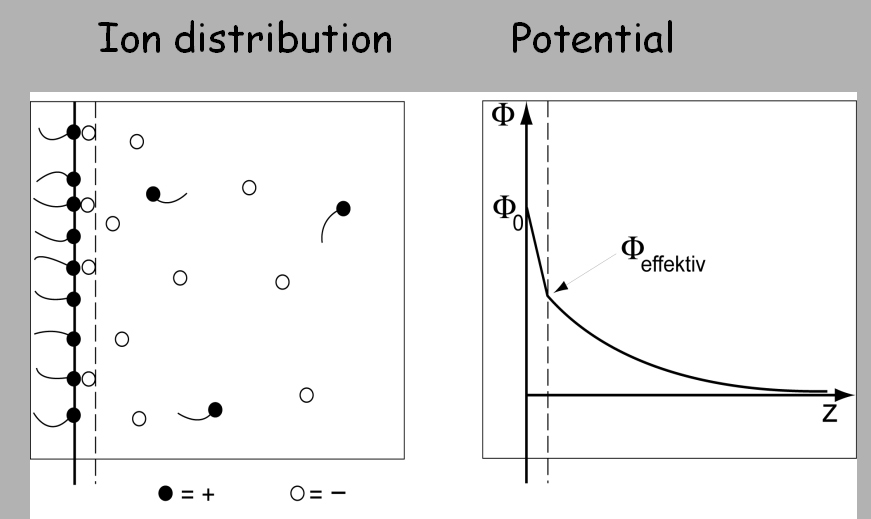
The puzzling effects of the Hofmeister series is the result of subtle balance of several competing evenly matched interactions. The complex interplay of electrostatics, dispersion forces, thermal motion, fluctuations, hydration,ion size effects and the impact of interfacial water structure make it hard or even impossible to identify an universal law. The diversity of specific ion effects as manifested by the Hofmeister series of ions is direct consequence of the subtle interplay of forces.The decisive information is completely contained in the ion distribution.We discuss simple approach developed in our laboratory providing first insights in the prevailing ion distribution at charged interface based on ellipsometry.The distribution of ions is transformed in layer with effective surface charge density and Poisson -Boltzmann distribution within the diffuse layer. Under these assumptions Fresnel ’s equations can be simplified to an analytical expression,which directly relates the effective surface charge density and the ellipsometric signal.The formula does not contain free parameters and can be used to interpret ellipsometric isotherms of charged interfaces.
Further reading:
R. Teppner, K. Haage, D. Wantke, H. Motschmann, " On the internal structure of an adsorption layer of an ionic soluble surfactant - The build-up of a Stern layer monitored by optical means" J. Phys. Chem. B, 104, 11489, (2000).
Koelsch P. Motschmann H. "Varying the counter-ions at a charged interface", Langmuir, (in press).
P. Koelsch, H. Motschmann, "A method for a direct determination of the prevailing counter-ion distribution at a charged surface" Journal of Physical Chemistry 108(48):18659-18664, (2004).
P. Koelsch, Hubert Motschmann, "An experimental route to Hofmeister" Curr. Opinion.in Coll. and Int.Sci. 9(1-2):87-91, (2004).
Ellipsometry-Cell tube design for adsorption measurements
Experimentally the great hurdle in performing in situ adsorption ellipsometric measurements is the design of a proper cell. Ellipsometry measures changes in the state of polarization upon reflection on a film covered surface. Hence all elements which may have an impact on the state of polarization should carefully be considered. The following items are of utmost importance:
The beam should hit the windows under normal incidence. In this case the state of polarization remains unchanged.
The cell window should not be birefringent. A birefringent plate acts as a phase retardation plate. This unwanted effect may also be caused by mechanical stress or thermal gradients.
Multiple reflection should be avoided which demands window with anti reflection coating.
The cell design should allow a precise alignment of a solid sample within the liquid. All alignment schemes based on an auto-collimation of a beam normal to the reflecting surface faces here severe hurdles. A four quadrant diode is the best choice for an accurate alignment. The cell should enable angle dependent ellipsometric measurements.
The user should have the possibility to change concentration of the dissolved species in solution.
Longtime measurement require the control of the temperature. The refractive index of the solution changes with the temperature which can be easily misinterpreted as surface effects.
Usually all these problems are tackled by a cell with windows fixed at a certain angle of incidence. Angle dependent measurements are not feasible in this arrangement as it is impossible to separate effects on the state of polarizationcaused by cell window and sample.
The angle of incidence is usually fixed to 70 degrees for all metallic supports, for dielectric layer a angle of 60 degrees is chosen. Both angles provide a good compromise between sensitivity and signal strength at the detector. There have also been several attempts to use cylinders as cells. However, it is quite tricky to align a cylinders and the curvature imposes always a significant and unwanted effect on the state of polarization.
An excellent solution for all above listed problem has been developed within the group of Tommy Nylander, Department of Physical Chemistry 1 and Department of Biophysical Chemistry Lund University, Sweden. The design of their cell solves all the outlined problems and enables even angle dependent measurements.The concept is especially appealing due to its simplicity. The authors fixed tubes on the laser and detectorarm of the Multiskop. At the end of the tubes optical windows are aligned o that the laser beam is retro reflected. These nozzles are put into the solution of interest. The beam remains well aligned even if the angle of incidence is changed.
Further reading:
J. Benjamins, B., Jonsson, K. Thuresson, T. Nylander,
New Experimental Setup To Use Ellipsometry To Study Liquid-Liquid
and Liquid-Solid Interfaces,
Langmuir, (2002), 18, 6437-6444
Ellipsometry - sensitivity analysis uniaxial
Further reading:
C. Flueraru, S. Schrader, V. Zauls, H. Motschmann
Sensitivity analysis of ellipsometry applied to uniaxial optical films
Thin Solid Films, 379, 15, (2000).
back to top
IMAGING ELLIPSOMETRY
Imaging ellipsometry - Interfacial transition region
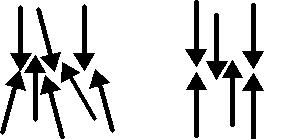
Liquid crystals are fluid systems which respond to slight changes in applied external forces. This feature makes them attractive for many applications e.g. in displays. In this respect, one important but still not completely understood process is the way in which liquid crystals are anchored to an interface and how this interfacial order effects the volume phase. The presence of a transition region (interface-bulk) seems to be a common feature of nematic liquid crystals and is confirmed by a great body of experimental evidence. However, smectic liquid crystals (layer structure) seem to lack this features. Our present contribution focuses in particular on this aspect.
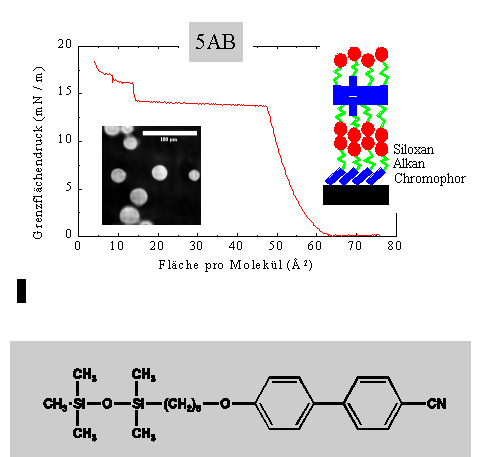
The triblock organosiloxane liquid crystalline 4-[pentamethyl--disiloxanyl--n-pentyloxy]- - $4'$-cyanodiphenyl 5AB, which forms a smectic $S_A$ phase in the bulk, was investigated at the air-water interface. Imaging nullellipsometry was employed for visualization of morphology and thickness determination. The surface pressure-area ($pi-A$)-isotherm exhibits several plateaus each corresponding to the formation of an interdigitated bilayer. The system is ideally suited for assessment of the influence of the interface on the order and structure of the smectic bulk phase.
Further reading:
M. Harke, M. Ibn Elhaj, H. Möhwald, H. Motschmann
Polar ordering of smectic liquid crystals within the interfacial region
Phys. Rev. E, 57, 1806, (1998).
Imaging ellipsometry - Transition oil-water interface
The transition state between the air-water and the oil-water interface is examined. An insoluble monolayer at the air-water interface is exposed to a gas phase containing organic hydrocarbons.

The hydrocarbons are partly incorporated within the monolayer. As a result, changes in the orientational order occur and new phases with different morphology are formed. The the esterdiol hexadecanoic-2,3-dihydroxypropylester, ESD-16 are used as amphiphiles and pentane, $n$-hexane, cyclohexane, 2,2 Dimethylbutane, $n$-heptane, $n$-decane, $n$-dodecan, as hydrocarbons. The structural changes are monitiored by surface pressure-area -isotherms and imaging ellipsometry. The influence of the chemical nature of the hydrocarbon and the effect of the partial pressure of the hydrocarbon on the monolayer structure is assessed.

back to top
SURFACE PLASMONS
Surface plasmons-mismatch
Further reading :
M. Schneider, A. Andersen, P. Koelsch, H. Motschmann
Following fast adsorption processes with surface plasmon spectroscopy: Reflectivity versus Mismatch Tracking
Sensors and Actuators, 104(2):276-281, (2005)
back to top
UNUSUAL EXPERIMENTS
Unusual experiments - Imaging below diffraction limit
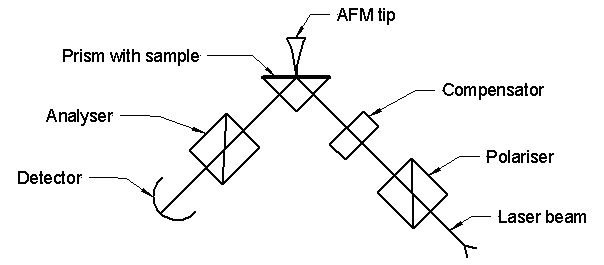
Ellipsometry enables the measurement of the fillm thickness to within Angstroem accuracy. This is fascinating considering the fact that the wavelength of light is on the order of 500 nm. The high accuracy is achieved due to an interference effect within the film structure. As a result the state of polarization is changed upon reàection.
Many real samples are inhomogeneous. The lateral inhomogeneity is then transfered in the reflected light and can be subsequently visualized with suitable imaging optics. The contrast giving mechanism is ellipsometry and the high vertical resolution of this technique is main- tained. The lateral resolution is given by the numerical aperture of the objective. The lateral resolution limit is given by diffraction and on the order of the wavelength of light. Recently an experiment has been described which overcomes the diffraction limit and allows a direct visualization of refractive index patterns with a much higher resolution. The arrangement is based on a combination of Atomic Force Microscopy (AFM) and Ellipsometry. In this experiment the resolution is determined by the geometrical dimensions of the AFM tip. The arrangement is illustrated in the following photo.
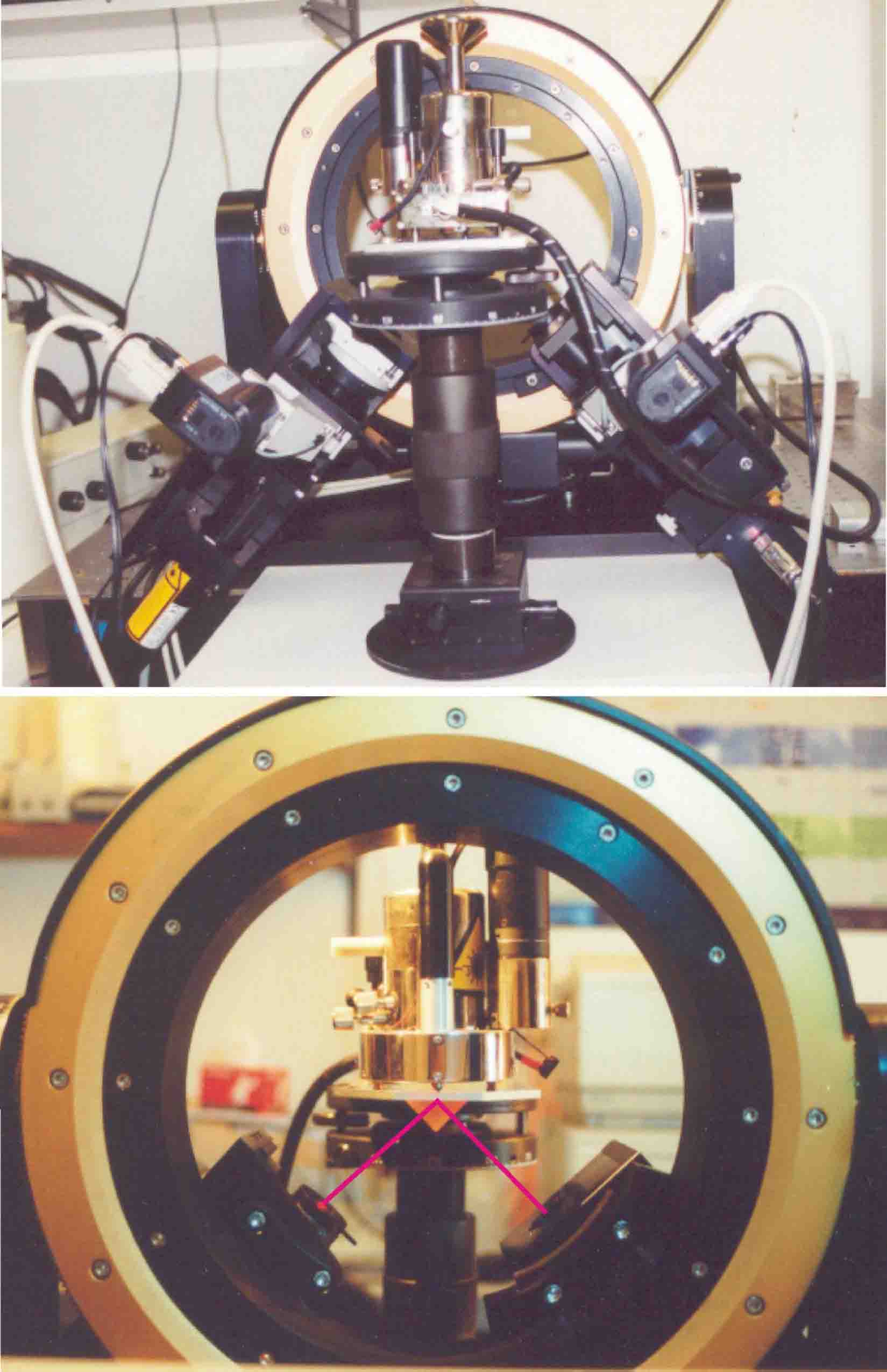
Unusual experiments - Ellipsometry on a pendant drop
A pendant drop can be regarded as a small Langmuir trough. The evaluation of the drop shape allows the determination of the surface tension and surface area. A change of the volume of the drop leads to a change in the surface area and enables the measurement of the surface pressure-area isotherms. This arrangement is in particular useful if you are using very precious materialsuch as certain biomolecules or if you want to measure at elevated temperature. It is by nomeans trivial to perform temperature runs on a Langmuir trough beyond 40 degrees C. On a droplet
this is easily feasible. In addition you can also perform experiments at liquid-liquid interfaces. It has been demonstrated that p-A isotherms of insoluble monolayers resemble identical features no matter if they are recorded on an conventional trough or by performing the drop shape analysis. However, in some cases major deviations have been observed. In these cases the domains possess a size of about 1/10 of the drop diameter. The curvature has an impact on the system. These eÞects are investigated in the following arrangement which addresses
the relation between curvature and morphology. The experiments may give access to the bending modulus of Langmuir layers spread on the surface of a pendant drop. The experiment requires a rotation of the optical arms of the Multiskop to more than 90 degrees.
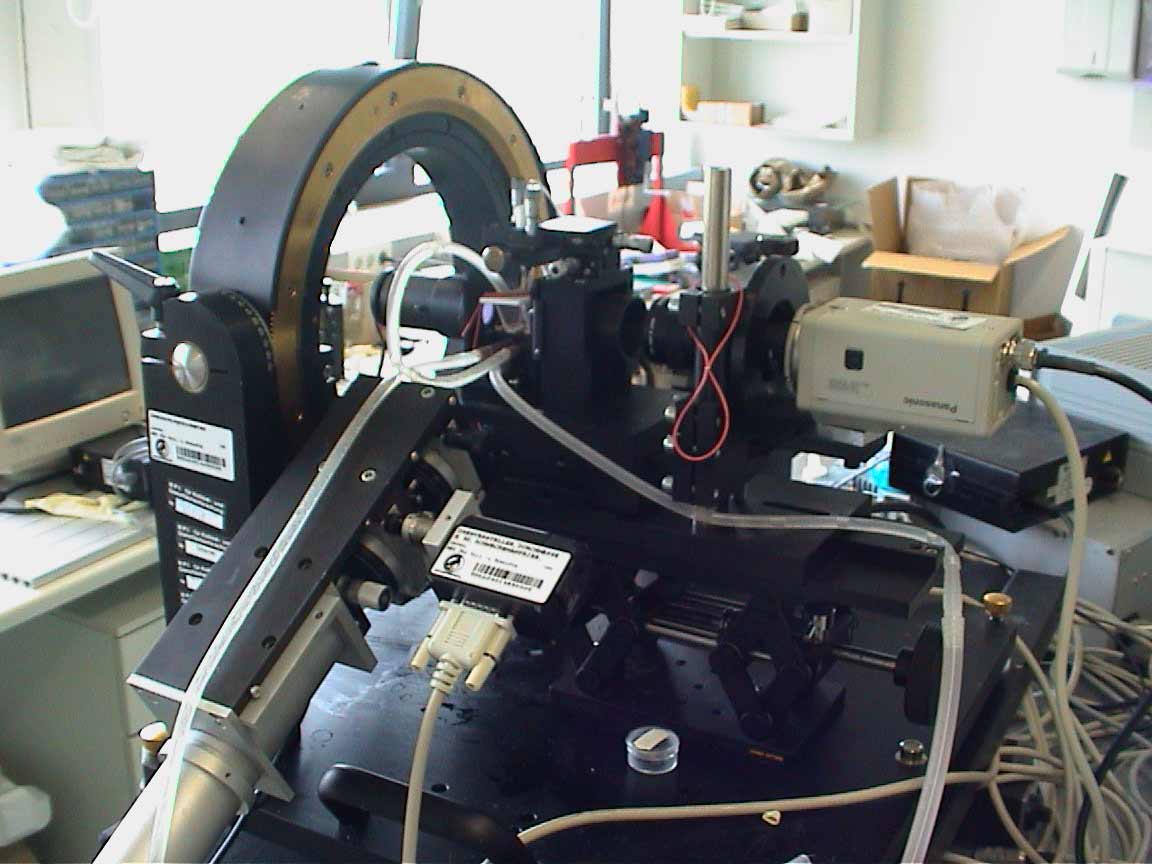
Further reading:
M. Ferrari, F. Ravera, L. Liggieri, H. Motschmann, Z. Yi, J. Krägel and R. Miller
Adsorption and surface rheology of n-dodecanol at the water/air interface
Journal of Colloid and Interface Science, 272(2):277-280, (2004).
back to top | 